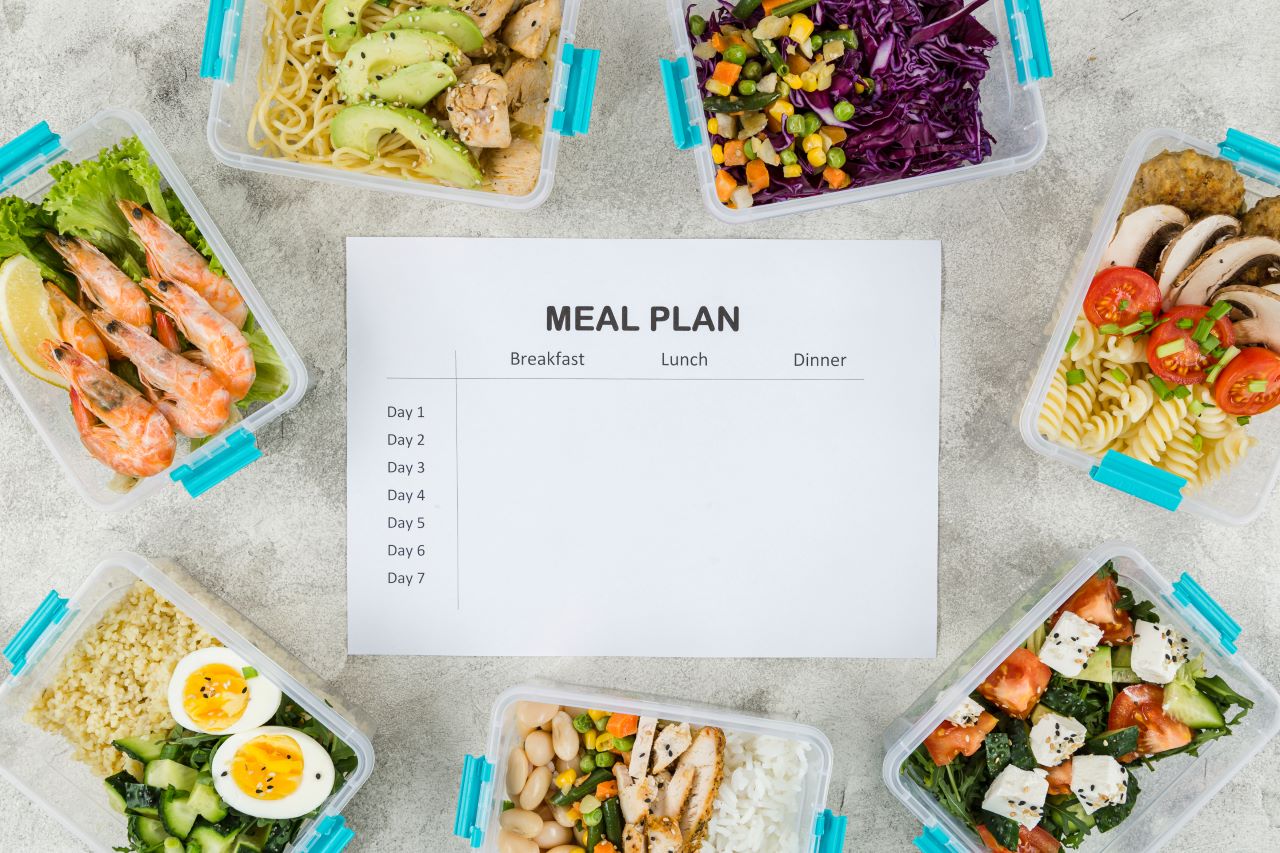In simple terms, a balanced diet plan for weight loss means eating the right kinds and amounts of food. It’s about making choices that give your body what it needs to be healthy while also helping you lose weight. Let’s dive into creating a plan that works for you!
When trying to lose weight, having a balanced diet is super important. Some people start their weight loss journey without really knowing what they’re doing, and they might believe things about diets that aren’t true. This article is here to help you make a good and long-lasting plan for losing weight through a balanced diet.
Importance of a Balanced Diet for Weight Loss
In the journey towards weight loss, maintaining a balanced diet cannot be emphasized enough. A balanced diet is pivotal in achieving and sustaining healthy weight loss goals. Here’s a comprehensive look at why a balanced diet is crucial for effective weight management:
Nutrient Adequacy:
- A balanced diet ensures that your body receives all the essential nutrients it needs to function optimally.
- Adequate intake of vitamins, minerals, proteins, carbohydrates, and fats supports various bodily functions.
Caloric Control:
- Balancing the intake of calories is fundamental to weight loss.
- A well-planned diet helps control calorie consumption, preventing excessive intake that can lead to weight gain.
Sustained Energy Levels:
The right balance of macronutrients, including carbohydrates, proteins, and fats, provides sustained energy throughout the day.
This helps in avoiding energy crashes and overeating due to hunger.
Muscle Preservation:
Protein, a crucial component of a balanced diet, aids in preserving lean muscle mass during weight loss.
Preserving muscle is essential for maintaining metabolic rate and ensuring long-term weight management.
Metabolic Boost:
Certain foods in a balanced diet can boost metabolism, facilitating the efficient burning of calories.
This contributes to more effective weight loss over time.
Digestive Health:
A diet rich in fiber from fruits, vegetables, and whole grains supports digestive health.
Good digestion is linked to weight loss and overall well-being.
Hormonal Balance:
A balanced diet helps regulate hormones related to hunger and satiety, such as leptin and ghrelin.
Hormonal balance reduces cravings and emotional eating, aiding in weight loss efforts.
Nutrient Timing:
Properly timed meals and snacks contribute to better nutrient absorption and utilization.
This optimizes the body’s ability to utilize nutrients for energy and metabolic processes.
Hydration Support:
Many fruits and vegetables in a balanced diet have high water content, contributing to overall hydration.
Proper hydration is essential for metabolism and can aid in weight loss.
Lifestyle Adaptability:
A balanced diet is adaptable to various lifestyles and preferences.
This flexibility makes it easier to sustain healthy eating habits in the long run.
Psychological Well-being:
Nutrient-dense foods in a balanced diet support brain health and mood.
Maintaining psychological well-being is crucial for staying motivated and avoiding emotional eating.
Disease Prevention:
A balanced diet helps prevent nutritional deficiencies and lowers the risk of chronic diseases associated with obesity.
Long-term weight loss is not just about appearance but also about overall health.
How do you create a balanced diet plan for weight loss?
Creating a balanced diet plan for weight loss involves thoughtful choices and a strategic approach to nourishing your body while shedding excess pounds. Here’s a brief and comprehensive guide on how to develop an effective and sustainable balanced diet plan:
Set Realistic Goals:
Setting realistic goals is the foundational step in any successful weight loss journey. Establishing achievable and meaningful objectives not only provides direction but also fosters motivation and adherence to a balanced diet plan. Here’s a comprehensive guide on how to set realistic goals for effective and sustainable weight loss:
Self-Reflection:
- Begin by reflecting on your current lifestyle, habits, and overall health.
- Consider your motivations for wanting to lose weight and how it aligns with your well-being.
Consult with Professionals:
- Schedule a consultation with a healthcare professional or a registered dietitian.
- Seek expert advice to understand your body’s specific needs, potential challenges, and appropriate weight loss goals.
Define Clear Objectives:
- Clearly define your weight loss objectives in terms of pounds, body fat percentage, or clothing size.
- Make your goals specific, measurable, and achievable within a reasonable timeframe.
Consider Health Metrics:
- Focus not only on weight but also on other health metrics such as cholesterol levels, blood pressure, and overall fitness.
- Holistic health goals contribute to a more comprehensive and sustainable approach to weight loss.
Understand Your Body:
- Acknowledge your body’s unique characteristics, including metabolism, genetics, and any pre-existing health conditions.
- Realistic goals should consider what is attainable for your circumstances.
Gradual Progress:
- Aim for gradual, steady progress rather than rapid weight loss.
- Sustainable weight loss typically ranges from 0.5 to 2 pounds per week, promoting healthier habits and minimizing the risk of regaining lost weight.
Behavioral Changes:
- Identify specific behaviors that contribute to weight gains, such as emotional eating or sedentary habits.
- Set goals focused on positive behavioral changes, creating a foundation for long-term success.
Break Down Larger Goals:
- If your overall weight loss goal is significant, break it into smaller, more manageable milestones.
- Celebrate achievements along the way, reinforcing positive behaviors and maintaining motivation.
Establish Timeframes:
- Set realistic timeframes for achieving your goals, considering your daily commitments and lifestyle.
- Understanding that weight loss is a gradual process helps manage expectations.
Adaptability:
- Recognize that circumstances may change, affecting your ability to adhere to the original plan.
- Be adaptable and open to modifying your goals based on your evolving needs and challenges.
Incorporate Non-Scale Victories:
- Include non-scale victories, such as improved energy levels, better sleep, or enhanced mood, as part of your goals.
- These achievements contribute to a more holistic and positive approach to weight loss.
Accountability and Support:
- Share your goals with friends, family, or a support group to create accountability.
- Having a support system can provide encouragement and guidance during challenging times.
Celebrate Achievements:
- Celebrate both minor and significant achievements to stay motivated.
- Recognizing your progress reinforces positive behaviors and strengthens your commitment to your weight loss journey.
Reevaluate and Adjust:
- Regularly reevaluate your goals and assess your progress.
- Adjust your goals as needed based on your evolving understanding of your body and any changes in your circumstances.
Prioritize Overall Well-Being:
- Prioritize overall well-being over a specific number on the scale.
- Focus on creating a balanced and sustainable lifestyle that supports your health and happiness.
By following these comprehensive guidelines, you can set realistic and meaningful goals that pave the way for a successful and sustainable weight loss journey. Remember, the key is to create a plan that aligns with your individual needs, promotes positive behaviors, and contributes to your overall well-being.
Understand Macronutrients and Micronutrients
Understanding Macronutrients
Macronutrients, including carbohydrates, proteins, and fats, form the foundation of any diet. Understanding their roles is crucial for creating a well-balanced meal plan.
Carbohydrates are often misunderstood. Learn how to incorporate the right carbs for sustained energy without hindering weight loss.
Proteins are vital in muscle development and can aid in weight loss. Discover how to incorporate lean protein sources into your diet effectively.
Contrary to popular belief, fats are essential for overall health. Uncover the types of fats that contribute to weight loss and how to include them in your diet.
Micronutrients and Their Role
Micronutrients, such as vitamins and minerals, are equally essential. Explore their impact on weight loss and overall well-being.
Certain vitamins play a specific role in metabolism and fat burning. Learn which vitamins are crucial for your weight loss journey.
Understanding the role of minerals like iron, calcium, and magnesium can enhance your diet’s effectiveness. Discover their significance in weight loss.
Incorporate Lean Proteins:
Include lean protein sources like poultry, fish, tofu, and legumes in your meals.
Protein aids in muscle preservation, metabolism, and feelings of fullness.
Choose Complex Carbohydrates:
Opt for whole grains, fruits, and vegetables as sources of complex carbohydrates.
These provide sustained energy and essential nutrients without causing rapid spikes in blood sugar.
Include Healthy Fats:
Integrate sources of healthy fats, such as avocados, nuts, and olive oil, in moderation.
Healthy fats support satiety and contribute to overall well-being.
Portion Control:
Practice portion control to manage calorie intake.
Be mindful of serving sizes to prevent overeating while still enjoying a variety of foods.
Prioritize Fiber-Rich Foods:
Include fiber-rich foods like vegetables, fruits, and whole grains to support digestion.
Fiber contributes to a feeling of fullness, reducing the likelihood of overindulging.
Hydration is Key:
Stay adequately hydrated by drinking plenty of water throughout the day.
Water supports metabolism and helps control appetite, aiding in weight loss.
Plan Balanced Meals:
Structure meals with a mix of macronutrients, ensuring a balanced combination of proteins, carbohydrates, and fats.
This approach promotes nutritional variety and enhances the effectiveness of your weight loss plan.
Consider Individual Preferences:
Customize your diet plan based on your personal preferences and dietary restrictions.
Tailoring your meals to your liking increases the likelihood of adherence.
Incorporate Variety:
Introduce a diverse range of foods to ensure a broad spectrum of nutrients.
A varied diet helps prevent nutritional deficiencies and supports overall health.
Meal Timing Matters:
Pay attention to meal timing to optimize energy levels and metabolism.
Distribute your meals and snacks throughout the day for sustained nourishment.
Combine Diet with Exercise:
Include regular physical activity to complement your balanced diet plan.
Exercise contributes to calorie burning, muscle maintenance, and overall well-being.
Monitor and Adjust:
Keep track of your progress by monitoring your food intake and weight.
Adjust your diet plan as needed to accommodate changes in your weight loss journey.
Stay Consistent and Patient:
Consistency is vital to successful weight loss.
Be patient with the process, and celebrate small milestones along the way.
By following these guidelines, you can create a balanced diet plan that aligns with your weight loss goals. Remember, adopting a sustainable and balanced approach is crucial for long-term success in achieving and maintaining a healthy weight.
Conclusion
A balanced diet plan for weight loss is a holistic approach that considers various factors, including nutrition, hydration, and exercise. By understanding the intricacies of macronutrients, micronutrients, and individual preferences, you can create a sustainable plan that promotes healthy weight loss.
Sustainability is key to long-term success. Encourage readers to embrace a balanced and sustainable approach to weight loss, focusing on gradual changes for lasting results.











